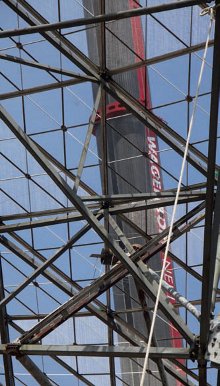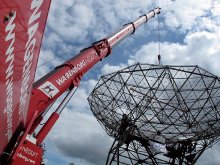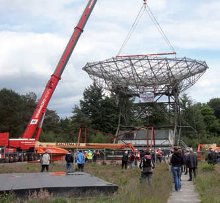Wagenborg helps scan the skies
30 July 2012Wagenborg Nedlift took part in a historic lift at the Dwingelderveld National Park in the Netherlands where the iconic Dwingeloo Radio Telescope was being restored.
Dwingeloo in Drenthe, the Netherlands has been home to the Dwingeloo Radio Telescope (DRT) for over half a century, and scientists conduct research there. With its place in history assured thanks to several significant contributions to the Dutch scientific community, including the discovery of two galaxies (Dwingeloo I and Dwingeloo II), DRT is now a national monument.
With a 25m-diameter dish, it was the world's largest single-disc radio telescope on its construction in 1956. It has been used for educational purposes and amateur astronomy only for the last five years.
Holstein Restoration Architecture (HRA) were brought into prevent the decay of its steel structure and project manage the telescope's maintenance and renewal.
Before HRA's subcontractor, MultiPaint Steel Preservation, could get to work, the telescope had to be lifted from its base tower. This gave Wagenborg Nedlift the ideal opportunity to break in its newly purchased Terex AC 500-2 all terrain crane.
It had only been used once before to lift a steam engine at the S.T.A.R Railway Museum in Stadskanaal.
Although originally planned for the early afternoon, Wagenborg had to wait until the evening to lift the 30t telescope, to the disappointment of some would-be spectators.
Wagenborg Nedlift's 500-tonner carefully separated the 56 year-old telescope from its base and positioned it on a specially constructed support base.
Maintenance and repair of damaged steel sections on the telescope has now been completed, and the sandblasting of the restored steel structure is currently underway. Following this the DRT, protected from the elements by a tent, will be repainted.
While amateur radio transmitters, amateur astronomers and educational establishments will be keen to see the telescope restored to its former glory, none will be more so than the Netherlands Institute for Radio Astronomy (ASTRON) scientists and other staff who are also based at the telescope.
ASTRON scientists at the DRT are working to develop software for the International LOFAR telescope, which combines signals from thousands of dipole antennas from over 48 stations to allow rapid survey and analysis of large swathes of the sky. By the end of November Holstein Restoration Architecture expect renovation of the telescope to be complete, when they will call once more on Wagenborg to finish the job and reinstall the DRT on its original base for another 50-year stint.


